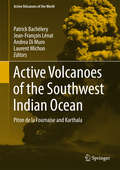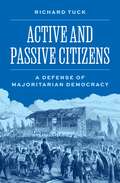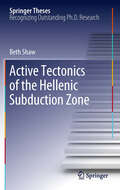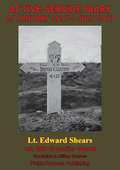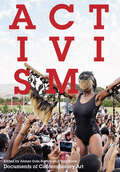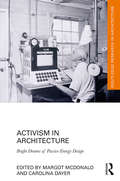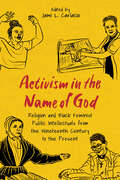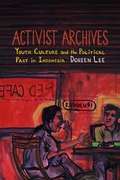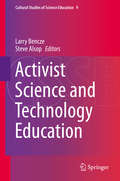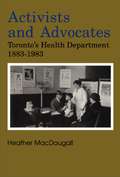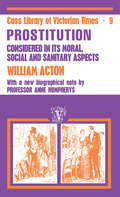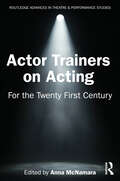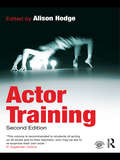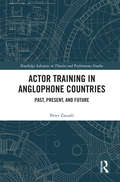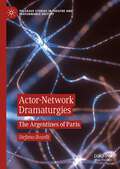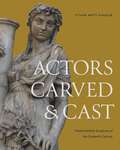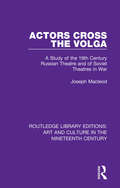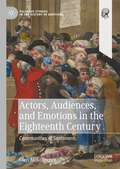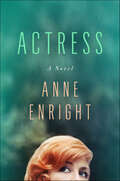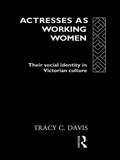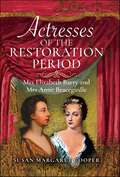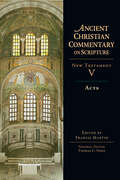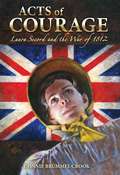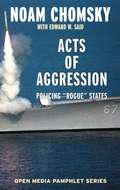- Table View
- List View
Active Volcanoes of the Southwest Indian Ocean: Piton de la Fournaise and Karthala (Active Volcanoes of the World)
by Patrick Bachelery Jean-François Lenat Andrea Di Muro Laurent MichonPiton de la Fournaise and Karthala are both shield volcanoes in the southwest Indian Ocean. This publication summarizes the work done on these very active basaltic volcanoes. Piton de la Fournaise has a long history of scientific research and monitoring, with many data collected during recent eruptions. It is certainly one of the most studied volcanoes in the world. The work presented in this monograph includes geological, geophysical, geochemical and petrological aspects, but also studies on physical geography, natural hazards and the sociological and behavioural approaches. ' The Karthala volcano may be less well known, but it serves as an interesting comparison to Piton de la Fournaise. Although situated close to the volcanoes of Hawaii, it differs from them by its more alkaline magmas and less frequent activity. It was also monitored for more than 25 years, producing extraordinary eruptions in recent years.
Active and Passive Citizens: A Defense of Majoritarian Democracy (The University Center for Human Values Series #56)
by Richard TuckA powerful case for why majority rule—not representation—is the defining feature of democratic politicsThe idea that democratic governance rests on active self-rule by citizens plays surprisingly little part in current theories of democracy, which instead stress the importance of representation by elected, appointed, or randomly selected bodies such as legislatures, courts, and juries. This would have astonished eighteenth-century theorists of democracy, who viewed universal suffrage and majoritarian voting as the sole criteria for democratic politics. Active and Passive Citizens defends the view of these earlier thinkers, asserting that individual agency is the very essence of democracy.In this provocative and lucidly argued book, Richard Tuck draws on the distinction made by the Abbé Sieyès, a leading political theorist of the French Revolution, between &“active&” citizens (the electorate) and &“passive&” ones (those who are represented by the institutions of the state). Tuck traces our current representative view of democracy to Sieyès and contrasts him with Rousseau, a theorist of active self-rule by the people. Tuck argues that modern theories of democracy have effectively turned us into passive citizens and calls for a renewal of a majoritarian democracy that realizes the full potential of active citizenship.Based on the prestigious Tanner Lectures delivered at Princeton University&’s Center for Human Values, Active and Passive Citizens is edited and introduced by Stephen Macedo and includes commentary by political theorists Simone Chambers, Joshua Cohen, John Ferejohn, and Melissa Schwartzberg.
Active tectonics of the Hellenic subduction zone (Springer Theses)
by Beth ShawThis thesis is remarkable for the wide range of the techniques and observations used and for its insights, which cross several disciplines. It begins by solving a famous puzzle of the ancient world, which is what was responsible for the tsunami that destroyed settlements in the eastern Mediterranean in 365 AD. By radiocarbon dating of preserved marine organisms, Shaw demonstrates that the whole of western Crete was lifted out of the sea by up to 10 meters in a massive earthquake at that time, which occured on a previously unknown fault. The author shows that the resulting tsunami would have the characteristics described by ancient writers, and uses modern GPS measurements and coastline geomorphology to show that the strain build-up near Crete requires such a tsunami-earthquake about every 6.000 years - a major insight into Mediterranean tsunami hazard. A detailed seismological study of earthquakes in the Cretan arc over the last 50 years reveals other important features of its behaviour that were previously unknown. Finally, she provides fundamental insights into the limitations of radiocarbon dating marine organisms, relating to how they secrete carbon into their skeletons. The thesis resulted in three major papers in top journals.
Active-Service Diary - 21 January 1917-1 July 1917
by Lieutenant Edward Hornby ShearsThe short, but poignant and action filled diary of a public school officer who fought with the Irish Guards in the Ypres Salient.EDWARD HORNBY SHEARS was born in Liverpool On December 4, 1890. His preparatory school was The Leas, Hoylake (1900-1904). In July, 1904, he obtained a Foundation Scholarship at Bradfield, and in December 1908 a History Exhibition at Trinity College, Oxford. He went up to Oxford in October, 1909, and obtained a 'second' in 'Mods' in 1910, and a 'first' in 'Greats' in 1913. In September, 1913, he passed into the Home Civil Service, and was appointed to the Secretaries' Department of the General Post Office. A year later (October, 1914) he became Principal Private Secretary to the Postmaster-General, Mr. (now Sir Charles) Hobhouse. He had been refused official permission to join the army at the outbreak of the War, but he received it in May, 1915, and obtained a commission in the 3/4th Queen's (Royal West Surrey) Regiment. A few months later he was promoted to lieutenant. After training for a year and a half in England, and having no apparent prospect of being sent to the front, he obtained a transfer to the Irish Guards, in which he received his commission as ensign in November, 1916. In January, 1917, he joined the 1st Battalion in France, where he was shortly promoted to lieutenant (dating from October 18, 1916). He was killed in action at Boesinghe on July 4, 1917, and on the following day he was buried at Canada Farm, Elverdinghe, near Ypres.
Activism (Whitechapel: Documents of Contemporary Art)
by Afonso Dias Ramos Tom SnowAn edited collection that addresses the vital intersection of contemporary art and activism in this watershed cultural moment.Activism is a critical point of contention for institutions and genealogies of contemporary art around the world. Yet artists have consistently engaged in activist discourse, lending their skills to social movements, and regularly participating in civil and social rights campaigns while also boycotting cultural institutions and exerting significant pressure on them. This timely volume, edited by Tom Snow and Afonso Ramos, addresses an extraordinary moment in debates over the institutional frameworks and networks of art including large-scale direct actions, as well as a radical rethinking of art venues and urban spaces according to racial, class, or gender-based disparities, including demonstrations against the extractive and exploitative practices of neoliberal accumulation and climate catastrophe.From ACT UP and its affiliate groups since the dawn of the AIDS crisis to the counter-spectacle and street theatrics of the so-called Arab Spring and Occupy, to ongoing protest movements such as Black Lives Matter, Rhodes Must Fall, and Decolonize This Place, activist aesthetics has proven increasingly difficult to define under traditional classifications. Resurgent campaigns for decolonial reckoning, ecological justice, gender equality, indigenous rights and antiracist pedagogies indicate that the role of activism in contemporary art practice urges a critical reassessment. One pressing question is whether contemporary art&’s most radical politics now takes place outside, against, or in spite of, conventional sites of display such as museums, biennials, and galleries.Artists surveyed include: ACT UP, Basel Abbas & Ruanne Abou-Rahme, Allora & Calzadilla, Tania Bruguera, Black Audio Film Collective, Chto Delat, Andrea Fraser, Nan Goldin, Sanja Iveković, Gulf Labor, Amar Kanwar, Leslie Labowitz, Liberate Tate, Sethembile Msezane, Zanele Muholi, Jan Nikolai Nelles & Nora Al-Badri, Decolonize This Place, Michael Rakowitz, Oliver Ressler. Writers include: Dave Beech, Judith Butler, Amílcar Cabral, Elias Canetti, Douglas Crimp, Jodi Dean, Gilles Deleuze, T.J. Demos, Nina Dubrovsky, Süreyyya Evren, Catherine Flood, Matthew Fuller, David Graeber, Gavin Grindon Félix Guattari, Brian Holmes, Carrie Lambert-Beatty, Lucy Lippard, Yates McKee, MTL Collective, Gregory Sholette, Françoise Vergès, Peter Weiss, Eyal Weizman.
Activism in Architecture: Bright Dreams of Passive Energy Design (Routledge Research in Architecture)
by Carolina Dayer Margot McDonaldThis edited collection gathers contributions from a diverse range of renowned scholars and professionals to uncover the unique relationship between passive architectural systems and activism. Focusing on the pioneering work of the influential American chemist and inventor, Harold R. Hay (1909–2009), and the environmental awareness events that took hold in the United States during the 1960s and 1970s, the book assembles essays which closely examine Hay's contribution to architecture and the work of those who directly and tangentially were affected by it. The book also offers insights into the role of passive energy design today. Appealing to researchers, architects and students interested in architecture and design technology, Activism in Architecture explores the role of passive environmental inventions as an active agent in shaping socio-political debates.
Activism in the Name of God: Religion and Black Feminist Public Intellectuals from the Nineteenth Century to the Present (Margaret Walker Alexander Series in African American Studies)
by Jami L. CarlacioContributions by Janet Allured, Lisa Pertillar Brevard, Jami L. Carlacio, Cheryl J. Fish, Angela Hornsby-Gutting, Jennifer McFarlane-Harris, Neely McLaughlin, Darcy Metcalfe, Phillip Luke Sinitiere, P. Jane Splawn, Laura L. Sullivan, and Hettie V. WilliamsActivism in the Name of God: Religion and Black Feminist Public Intellectuals from the Nineteenth Century to the Present recognizes and celebrates twelve Black feminists who have made an indelible mark not just on Black women’s intellectual history but on American intellectual history in general. The volume includes essays on Jarena Lee, Theressa Hoover, Pauli Murray, and Alexis Pauline Gumbs, to name a few. These women’s commitment to the social, political, and economic well-being of oppressed people in the United States shaped their work in the public sphere, which took the form of preaching, writing, singing, marching, presiding over religious institutions, teaching, assuming leadership roles in the civil rights movement, and creating politically subversive print and digital art. This anthology offers readers exemplars with whose minds and spirits we can engage, from whose ideas we can learn, and upon whose social justice work we can build.The volume joins a burgeoning chorus of texts that calls attention to the creativity of Black women who galvanized their readers, listeners, and fellow activists to seek justice for the oppressed. Pushing back on centuries of institutionalized injustices that have relegated Black women to the sidelines, the work of these Black feminist public intellectuals reflects both Christian gospel ethics and non-Christian religious traditions that celebrate the wholeness of Black people.
Activist Archives: Youth Culture and the Political Past in Indonesia
by Doreen LeeIn Activist Archives Doreen Lee tells the origins, experiences, and legacy of the radical Indonesian student movement that helped end the thirty-two-year dictatorship in May 1998. Lee situates the revolt as the most recent manifestation of student activists claiming a political and historical inheritance passed down by earlier generations of politicized youth. Combining historical and ethnographic analysis of "Generation 98," Lee offers rich depictions of the generational structures, nationalist sentiments, and organizational and private spaces that bound these activists together. She examines the ways the movement shaped new and youthful ways of looking, seeing, and being--found in archival documents from the 1980s and 1990s; the connections between politics and place; narratives of state violence; activists' experimental lifestyles; and the uneven development of democratic politics on and off the street. Lee illuminates how the interaction between official history, collective memory, and performance came to define youth citizenship and resistance in Indonesia's transition to the post-Suharto present.
Activist Science and Technology Education (Cultural Studies of Science Education #9)
by Larry Bencze Steve AlsopThis collection examines issues of agency, power, politics and identity as they relate to science and technology and education, within contemporary settings. Social, economic and ecological critique and reform are examined by numerous contributing authors, from a range of international contexts. These chapters examine pressing pedagogical questions within socio-scientific contexts, including petroleum economies, food justice, health, environmentalism, climate change, social media and biotechnologies. Readers will discover far reaching inquiries into activism as an open question for science and technology education, citizenship and democracy. The authors call on the work of prominent scholars throughout the ages, including Bourdieu, Foucault, Giroux, Jasanoff, Kierkegaard, Marx, Nietzsche, Rancière and Žižek. The application of critical theoretical scholarship to mainstream practices in science and technology education distinguishes this book, and this deep, theoretical treatment is complemented by many grounded, more pragmatic exemplars of activist pedagogies. Practical examples are set within the public sphere, within selected new social movements, and also within more formal institutional settings, including elementary and secondary schools, and higher education. These assembled discussions provide a basis for a more radically reflexive reworking of science and technology education. Educational policy makers, science education scholars, and science and technology educators, amongst others, will find this work thought-provoking, instructive and informative.
Activists and Advocates: Toronto's Health Department 1883-1983
by Heather MacdougallFor more than a century, Toronto’s Health Department has served as a model of evolving municipal public health services in Canada and beyond. From horse manure to hippies and small pox to AIDS, the Department’s staff have established and maintained standards of environmental cleanliness and communicable disease control procedures that have made the city a healthy place to live. This centennial history anlyzes the complex interaction of politics, patronage and professional aspirations which determine the success or failure of specific policies and programs. As such, it fills a long neglected gap in our understanding of the development of local health services. Using Toronto’s changing circumstances as a backdrop, the book details the evolution of the international public health movement through its various phases culminating in the modern emphasis on health promotion and health advocacy. By so doing, it demonstrates the significant contribution of preventive medicine and public health activities to Canadian life
Acton: In London And Other Large Cities; With Proposals For The Mitigation And Prevention Of Its Attendant Evils (classic Reprint)
by William ActonPublished in the year 1972, Action: Prostitution Considered is a valuable contribution to the field of History.
Actor Trainers on Acting: For the Twenty First Century (Routledge Advances in Theatre & Performance Studies)
by Anna McNamaraActor Trainers on Acting is a comprehensive, diverse and forwardthinking examination of the craft of acting written by leading experts from across the world.The book reflects on the evolving relationship between actor training and the contemporary and future world and considers how directly actor training relates to the living experiences of its stakeholders. Examining the training provider’s role in looking forward to a sustainable and resilient future, this book considers what opportunities there are to be created within performance training and what can be done to enable them. Seeking to provide those teaching, facilitating and leading performance training with ideas and practical steps, this book will be invaluable to students, teachers, practitioners and academics alike.Each chapter features an interview and reflection from leaders drawn from actor training resulting in innovative and insightful individual chapters. The progression is structured to consciously develop the central theme, outlining approaches to contemporary actor training that respond directly to our times globally, building on the foundations of traditions and utilising learning to embolden a confident and resilient training for future students, teachers and industries.
Actor Training
by Alison HodgeActor Training expands on Alison Hodge's highly-acclaimed and best-selling Twentieth Century Actor Training. This exciting second edition radically updates the original book making it even more valuable for any student of the history and practice of actor training. The bibliography is brought right up to date and many chapters are revised. In addition, eight more practitioners are included - and forty more photographs - to create a stunningly comprehensive study. The practitioners included are: Stella Adler; Eugenio Barba; Augusto Boal; Anne Bogart; Bertolt Brecht; Peter Brook; Michael Chekhov; Joseph Chaikin; Jacques Copeau; Philippe Gaulier; Jerzy Grotowski; Maria Knebel; Jacques Lecoq; Joan Littlewood; Sanford Meisner; Vsevolod Meyerhold; Ariane Mnouchkine; Monika Pagneux; Michel Saint-Denis; Włodzimierz Staniewski; Konstantin Stanislavsky; Lee Strasberg The historical, cultural and political context of each practitioner's work is clearly set out by leading experts and accompanied by an incisive and enlightening analysis of the main principles of their training, practical exercises and key productions. This book is an invaluable introduction to the principles and practice of actor training and its role in shaping modern theatre.
Actor Training in Anglophone Countries: Past, Present and Future (Routledge Advances in Theatre & Performance Studies)
by Peter ZazzaliActor Training in Anglophone Countries offers a firsthand account of the most significant acting programs in English-speaking countries throughout the world. The culmination of archival research and fieldwork spanning six years, it is the only work of its kind that studies the history of actor training from an international perspective. It presents the current moment as crucial for student actors and those who teach them. As the profession continues to change, new and progressive approaches to training have become as urgent as they are necessary. Using drama schools and universities as its subjects of inquiry, this book investigates acting programs in the UK, Ireland, the US, Canada, Australia, and New Zealand. Among the case studies are the Royal Academy of Dramatic Art, National Theatre School of Canada, Western Australian Academy of Performing Arts, and Carnegie Mellon University. All recognized for their distinguished reputations by industry professionals and acting teachers alike, the book examines each program’s pedagogical approach, administrative structure, funding apparatus, and alumni success. In doing so, it identifies the challenges facing acting schools today and offers a new direction for training in the twenty-first century. Actor Training in Anglophone Countries will be of interest to theatre and performance scholars, artists, students, and teachers.
Actor-Network Dramaturgies: The Argentines of Paris (Palgrave Studies in Theatre and Performance History)
by Stefano BoselliThis book provides key critical tools to significantly broaden the readers’ perception of theatre and performance history: in line with posthuman thought, each chapter engages Actor-Network Theory and similar theories to reveal a comprehensive range of human and non-human agents whose collaborations impact theatre productions but are often overlooked. The volume also greatly expands the information available in English on the networks created by several Argentine artists. Through a transnational, transatlantic perspective, case studies refer to the lives, theatre companies, staged productions, and visual artworks of a number of artists who left Buenos Aires during the 1960s due to a mix of personal and political reasons. By establishing themselves in the French capital, queer playwright Copi and directors Jorge Lavelli, Alfredo Arias, and Jérôme Savary, among others, became part of the larger group of intellectuals known as “the Argentines of Paris” and dominated the Parisian theatre scene between the 1980s and 90s. Focusing on these Argentine artists and their nomadic peripeteias, the study thus offers a detailed description of the complexity of agencies and assemblages inextricably involved in theatre productions, including larger historical events, everyday objects, sexual orientation, microbes, and even those agents at work well before a production is conceived.
Actors Carved and Cast: Netherlandish Sculpture of the Sixteenth Century
by Ethan Matt KavalerPainting has long dominated discussions of Netherlandish art. Yet in the sixteenth century sculpture was held in considerably higher regard than painting, especially in foreign lands. This beautifully illustrated book is the first comprehensive study of sixteenth-century Netherlandish sculpture, and it opens an important window onto the works and milieu of these artists. Netherlanders dominated the sculptural world of northern Europe. They made the most prestigious tombs and altarpieces, alabaster reliefs, and boxwood collectibles for patrons throughout Iberia, France, and Central Europe. Even in Italy they were a formidable presence; the most famous sculptor in Europe in the second half of the sixteenth century was Giambologna, a Fleming who spent the greater part of his career in Florence. A great many of these artists immigrated to foreign courts—so many that the history of Netherlandish sculpture in the second half of the sixteenth century plays out largely abroad. Netherlandish carvers and casters relocated to what are today Austria, Denmark, England, France, Germany, Italy, Poland, Portugal, Spain, Sweden, and Ukraine. Sculpture, more so than painting, was an essential tool in discourses of power.Offering an essential new perspective on a fascinating period in art history, Actors Carved and Cast will appeal to scholars of sculpture and all those interested in Northern Renaissance art.
Actors Cross the Volga: A Study of the 19th Century Russian Theatre and of Soviet Theatres in War (Routledge Library Editions: Art and Culture in the Nineteenth Century #6)
by Joseph MacleodFirst published in 1946. In this study of Russian theatre, the author explores the developments of drama and the theatre throughout the nineteenth-century. Macleod examines imperial and serf theatres, the impact of Russian drama on the east and west, and the regeneration of theatre at the start of the twentieth-century. This title will be of great interest to students of Theatre Studies and Russian History.
Actors and Audience in the Roman Courtroom (Routledge Monographs In Classical Studies)
by Leanna BablitzWhat would you see if you attended a trial in a courtroom in the early Roman empire? What was the behaviour of litigants, advocates, judges and audience? It was customary for Roman individuals out of general interest to attend the various courts held in public places in the city centre and as such the Roman courts held an important position in the Roman community on a sociological level as well as a letigious one. This book considers many aspects of Roman courts in the first two centuries AD, both civil and criminal, and illuminates the interaction of Romans of every social group. Actors and Audience in the Roman Courtroom is an essential resource for courses on Roman social history and Roman law as a historical phenomenon.
Actors, Audiences, and Emotions in the Eighteenth Century: Communities of Sentiment (Palgrave Studies in the History of Emotions)
by Glen McGillivrayThis book offers an innovative account of how audiences and actors emotionally interacted in the English theatre during the middle decades of the eighteenth century, a period bookended by two of its stars: David Garrick and Sarah Siddons. Drawing upon recent scholarship on the history of emotions, it uses practice theory to challenge the view that emotional interactions between actors and audiences were governed by empathy. It carefully works through how actors communicated emotions through their voices, faces and gestures, how audiences appraised these performances, and mobilised and regulated their own emotional responses. Crucially, this book reveals how theatre spaces mediated the emotional practices of audiences and actors alike. It examines how their public and frequently political interactions were enabled by these spaces.
Actress: A Novel
by Anne EnrightLonglisted for the 2020 Women's Prize for Fiction One of Time's 100 Must-Read Books of 2020 “A critique, a confession, a love letter—and another brilliant novel from Anne Enright.” —Ron Charles, Washington PostKatherine O’Dell is an Irish theater legend. Every moment of her life is a performance, with her daughter, Norah, standing in the wings. With age, alcohol, and dimming stardom, however, Katherine’s grip on reality grows fitful. Fueled by a proud and long-simmering rage, she commits a bizarre crime.As Norah’s role gradually changes to Katherine’s protector, caregiver, and finally legacy-keeper, she revisits her mother’s life of fiercely kept secrets; and Norah confronts in turn the secrets of her own sexual and emotional coming-of-age. With virtuosic storytelling, Actress weaves together two generations of women with difficult sexual histories, touching a raw and timely nerve.
Actresses as Working Women: Their Social Identity in Victorian Culture (Gender in Performance)
by Tracy C. DavisUsing historical evidence as well as personal accounts, Tracy C. Davis examines the reality of conditions for `ordinary' actresses, their working environments, employment patterns and the reasons why acting continued to be such a popular, though insecure, profession. Firmly grounded in Marxist and feminist theory she looks at representations of women on stage, and the meanings associated with and generated by them.
Actresses of the Restoration Period: Mrs Elizabeth Barry and Mrs Anne Bracegirdle
by Susan Margaret CooperThe Restoration represents an exhilarating period of English history. With Charles II, the ‘Merry Monarch’ restored to the throne, the country saw artistic and literary talent flourish. Charles was an enthusiastic patron of the theatre and helped breathe new life into British drama, reopening the playhouses after the gray years of closure under Puritanical rule. One of the most significant innovations in Restoration theatre was the introduction of actresses on the English stage. This exciting new history is dedicated to the life and times of two of the Restoration’s most celebrated actresses: Mrs Elizabeth Barry and Mrs Anne Bracegirdle. It details their family roots, the beginnings and progression of their London stage careers, their retirement from the limelight, and their eventual demise. Their lives and work are set against the lively and often dangerous atmosphere that epitomized seventeenth-century London and its theaters, and the places where Mrs Barry and Mrs Bracegirdle lived and worked alongside their fellow players, dramatists and others of their times. There are references to the actresses’ admirers and lovers within and without the world of theatre. Along with more favorable critical appraisals, there are explicit and derogatory lines, satirically written, regarding their supposed reputations. This insightful biography places Elizabeth and Anne back in the limelight, and includes transcriptions taken from contemporary works, letters, poems and wills, all adding depth and color to this fascinating subject.
Acts (Ancient Christian Commentary on Scripture #5)
by Thomas C. Oden Francis Martin Evan SmithHomilies on the Acts of the Apostles,Commentary on the Acts of the ApostlesCatena in Acta SS. Apostolorum.
Acts Of Courage: Laura Secord And The War Of 1812
by Connie Brummel CrookIn Acts of Courage, Connie Brummel Crook dramatizes the life of one of Canada's most enduring heroines, Laura Secord. From young Laura Ingersoll's early days in Great Barrington, Massachusetts, amidst the turmoil that followed the American Revolutionary War, the story outlines her father's difficult decision to move his family to Upper Canada. Laura's subsequent meeting and courtship with James Secord is described against the backdrop of homesteading in the Niagara Peninsula and of enduring the imminent threat of American invasion. These first sections of the book provide the background for Laura's courageous rescue of her husband from the battlefield at Queenston Heights, and her even more amazing trek to warn Col. FitzGibbon of the American's secret plans to attack the British outpost at Beaver Dams. Laura's extraordinary life, peopled with characters like Joseph Brant and Col. Fitzgibbon, is given even more poignancy and interest by the author's inventive and surprising characterization of the young FitzGibbon, by her acute eye for historical detail, and through her insights into the character of a young woman whose acts of courage have captured the imagination of generations of young Canadians.
Acts of Aggression: Policing Rogue States (Open Media Series #No. 13)
by Noam Chomsky Edward W. Said Ramsey ClarkIn Acts of Aggression three distinguished activist scholars examine the background and ramifications of the U.S. conflict with Iraq. Through three separate essays, the pamphlet provides an in-depth analysis of U.S./Arab relations, the contradictions and consequences of U.S. foreign policy toward "rogue states," and how hostile American actions abroad conflict with UN resolutions and international law.
